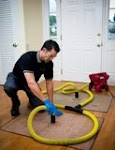
Before you start decorating your home for the holidays, it's a good idea to take the time to educate yourself about Christmas light safety. Holiday lights can add a festive touch to your home inside and out, as long as they are used as directed, observing all the necessary safety precautions.
Before Hanging Holiday Lights there are several things you need to do to ensure that your Christmas lights are safe before you hang them up.
• Verify Proper Rating - Bargain lights aren't a good deal if they pose a fire hazard. Only use lights that have been tested and rated by Underwriter's Laboratory (UL) or Intertek (ETL Semko). Strings of lights that have a safety rating are clearly marked, both on the packaging and with labels attached to the electrical cords.
• Check for Fraying - When you remove your holiday lights from storage, check the cords to make sure they are not frayed or otherwise damaged. Hanging lights with damaged cords can lead to an electrical short. This can damage your other lights and holiday decorations, as well as potentially lead to a fire. If you discover damaged strings of lights, throw them away.
• Use as Directed - There is a big difference between indoor holiday lights and outdoor holiday lights. Before hanging lights, make sure that you are using the fixtures only in the environment in which they were designed to be used.
• Choose Locations Carefully - Avoid hanging holiday lights near any item that poses a potential fire hazard, such as candles, space heaters, fireplaces, etc. Make sure bulbs aren't too close to loose paper or any other flammable materials that present a safety hazard.
• Hang Carefully - Never use tacks, staples, or nails to hang up your holiday light display. Instead, use insulated holders designed especially for this purpose.
Select Extension Cords Wisely - There's a good chance that you are going to need extension cords to complete your holiday lighting display. Make sure you have a sufficient quantity and length of grounded extension cords for the amount of the lights you plan to use. Do not overload extension cords with more wattage than they are designed to accommodate. It's also important to verify that any extension cords you are planning to use outside are rated for exterior use. Place Extension Cords Properly - Make sure that cords are placed so as to avoid posing a tripping hazard. Verify that they are not pulled taut, so there isn't an elevated risk of them pulling over your Christmas tree or other decorations. Turn Lights Off When Away - Do not leave holiday lights on when your house is unattended or when everyone in the home is asleep. In the event that a problem develops with your light display, it's essential that someone be on hand and alert to react quickly to avoid damage, a serious fire, and injuries.
Bulb Replacement - When bulbs burn out, it's important to replace them right away. It's dangerous to have light strings plugged in with empty sockets. Be sure that the replacement bulbs you select are the correct wattage.
Metal trees and holiday lights don't mix.- If you choose a metal Christmas tree, do not hang lights on it. There are several risks associated with metal lights and trees, including a high likelihood of fire and electric shock injuries.
Consider child safety - Children and holiday lights can be a dangerous combination. Kids like shiny objects, but playing with holiday lights can be very dangerous. Be very careful to place lights out of reach of children.
Observe OSHA Standards at Work – When hanging holiday lights in your office, make sure that your decorations are fully compliant with Occupational Safety and Health Administration (OSHA) standards for workplace safety. Don't let your holiday season be spoiled by failing to observe proper Christmas light safety practices. It's not difficult to have a safe and beautiful holiday display as long as you avoid taking shortcuts and observe proper electrical safety procedures.
• Verify Proper Rating - Bargain lights aren't a good deal if they pose a fire hazard. Only use lights that have been tested and rated by Underwriter's Laboratory (UL) or Intertek (ETL Semko). Strings of lights that have a safety rating are clearly marked, both on the packaging and with labels attached to the electrical cords.
• Check for Fraying - When you remove your holiday lights from storage, check the cords to make sure they are not frayed or otherwise damaged. Hanging lights with damaged cords can lead to an electrical short. This can damage your other lights and holiday decorations, as well as potentially lead to a fire. If you discover damaged strings of lights, throw them away.
• Use as Directed - There is a big difference between indoor holiday lights and outdoor holiday lights. Before hanging lights, make sure that you are using the fixtures only in the environment in which they were designed to be used.
• Choose Locations Carefully - Avoid hanging holiday lights near any item that poses a potential fire hazard, such as candles, space heaters, fireplaces, etc. Make sure bulbs aren't too close to loose paper or any other flammable materials that present a safety hazard.
• Hang Carefully - Never use tacks, staples, or nails to hang up your holiday light display. Instead, use insulated holders designed especially for this purpose.
Select Extension Cords Wisely - There's a good chance that you are going to need extension cords to complete your holiday lighting display. Make sure you have a sufficient quantity and length of grounded extension cords for the amount of the lights you plan to use. Do not overload extension cords with more wattage than they are designed to accommodate. It's also important to verify that any extension cords you are planning to use outside are rated for exterior use. Place Extension Cords Properly - Make sure that cords are placed so as to avoid posing a tripping hazard. Verify that they are not pulled taut, so there isn't an elevated risk of them pulling over your Christmas tree or other decorations. Turn Lights Off When Away - Do not leave holiday lights on when your house is unattended or when everyone in the home is asleep. In the event that a problem develops with your light display, it's essential that someone be on hand and alert to react quickly to avoid damage, a serious fire, and injuries.
Bulb Replacement - When bulbs burn out, it's important to replace them right away. It's dangerous to have light strings plugged in with empty sockets. Be sure that the replacement bulbs you select are the correct wattage.
Metal trees and holiday lights don't mix.- If you choose a metal Christmas tree, do not hang lights on it. There are several risks associated with metal lights and trees, including a high likelihood of fire and electric shock injuries.
Consider child safety - Children and holiday lights can be a dangerous combination. Kids like shiny objects, but playing with holiday lights can be very dangerous. Be very careful to place lights out of reach of children.
Observe OSHA Standards at Work – When hanging holiday lights in your office, make sure that your decorations are fully compliant with Occupational Safety and Health Administration (OSHA) standards for workplace safety. Don't let your holiday season be spoiled by failing to observe proper Christmas light safety practices. It's not difficult to have a safe and beautiful holiday display as long as you avoid taking shortcuts and observe proper electrical safety procedures.


